Abstract
Treatment of guinea pigs with cyclophosphamide before immunization with killed tularemia vaccine in Freund incomplete adjuvant produced a prolongation and intensification of delayed-type hypersensitivity and in vitro lymphocyte transformation reactions to tularemia antigen. Such reactions resemble those ordinarily associated with the administration of live tularemia vaccine, killed vaccine in Freund complete adjuvant, or recovery from natural infection. The immunopotentiation lasted longer than that seen previously in other antigenic systems with this drug and was dependent on the dose of vaccine used. More intense delayed skin reactivity could be transferred into normal controls by cells from immunized donors pretreated with cyclophosphamide than by cells from immunized donors that were not pretreated.
Full text
PDF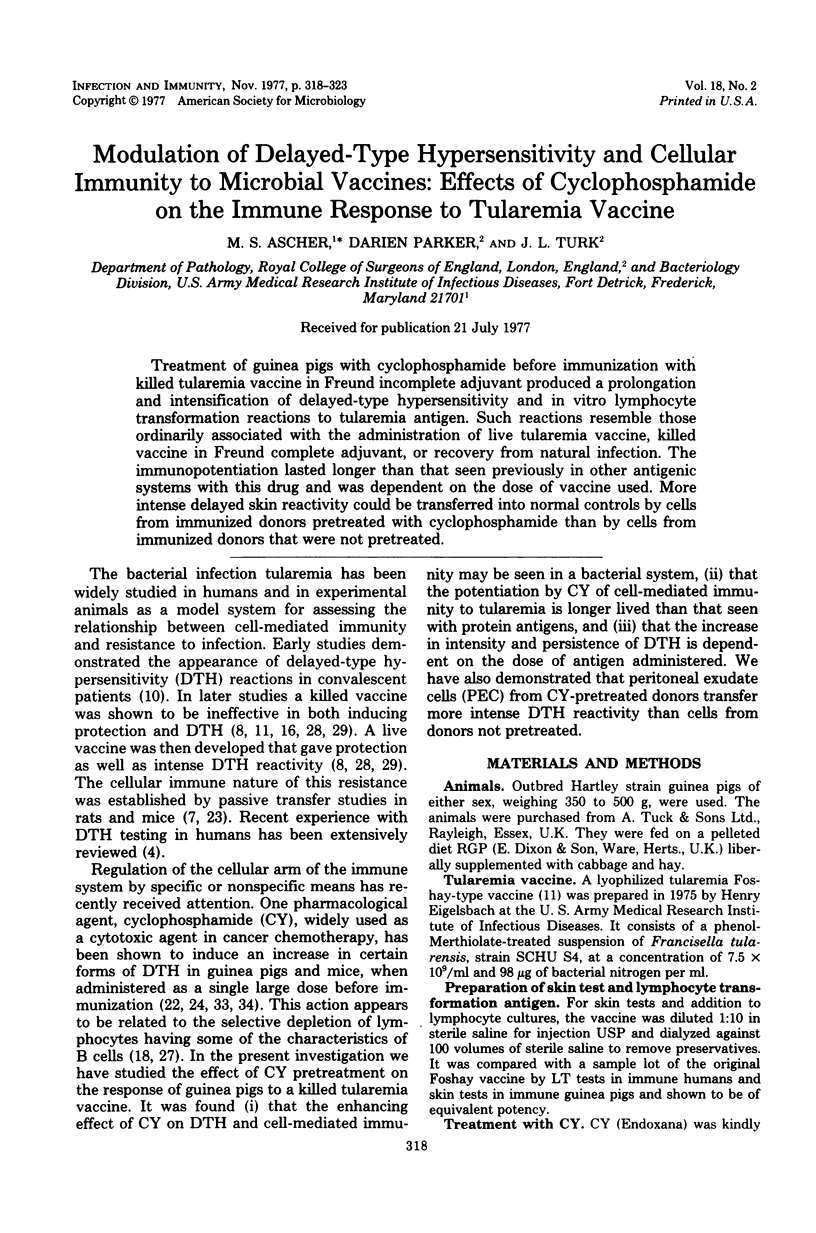
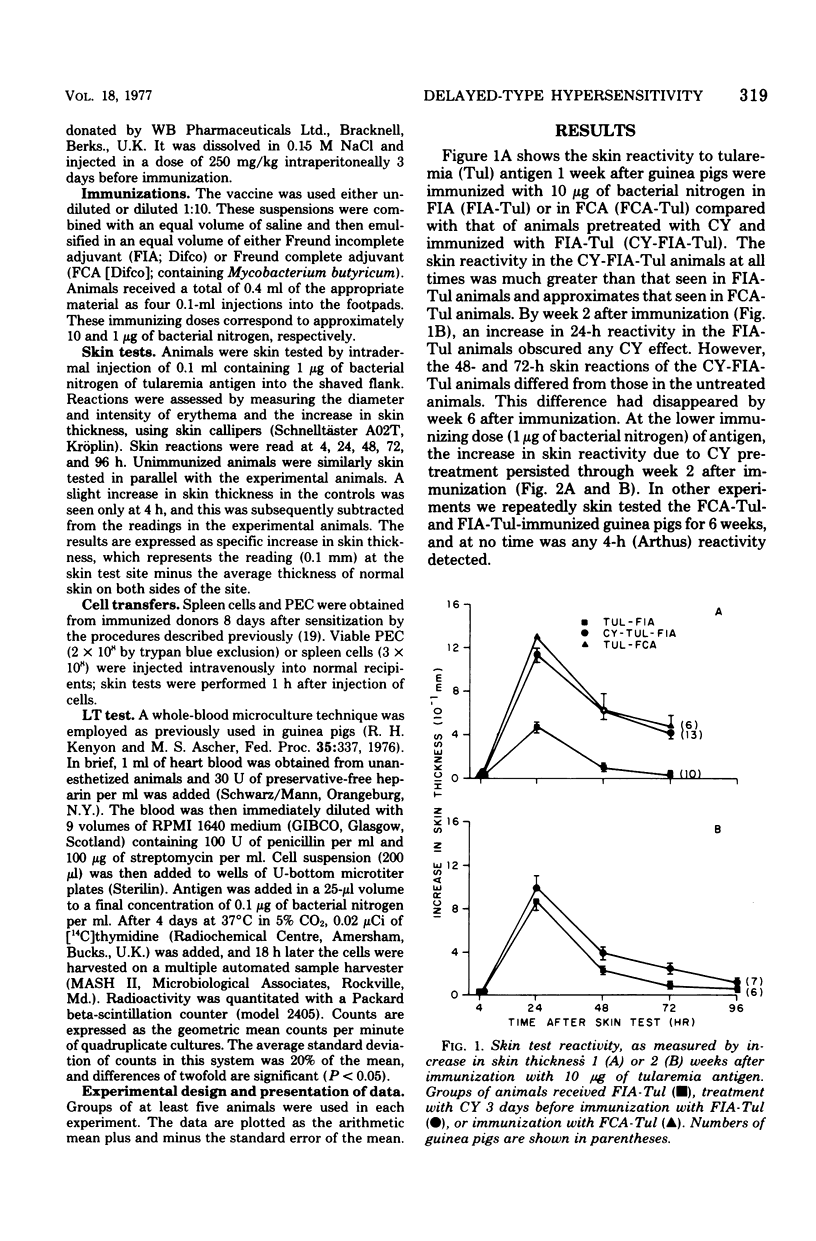
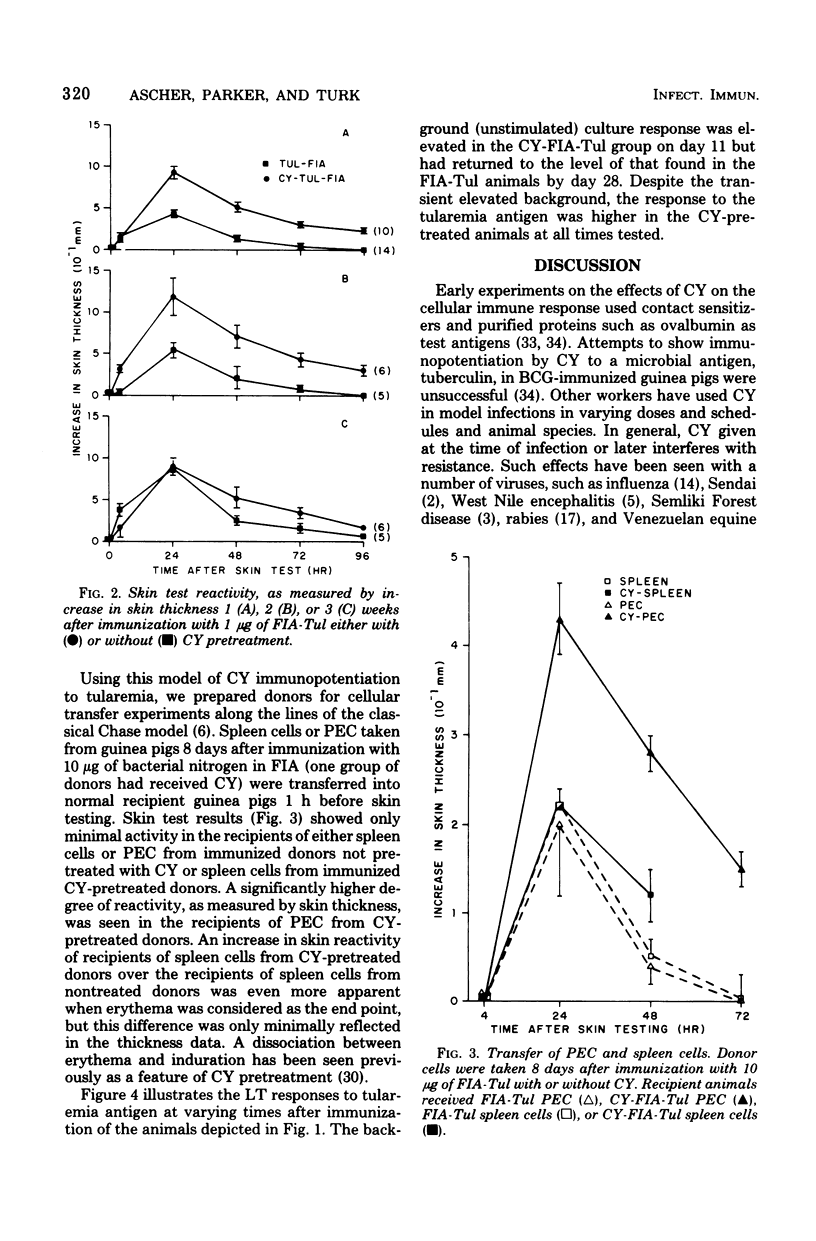
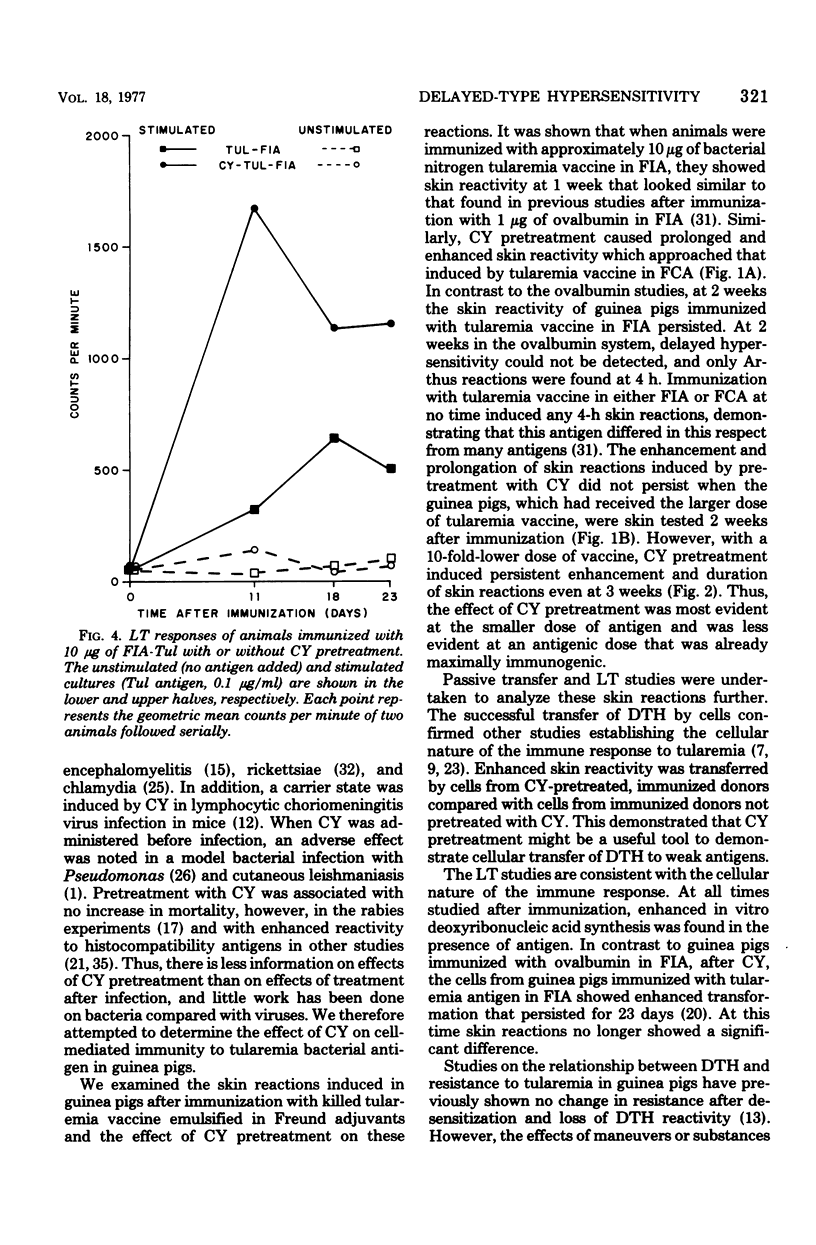
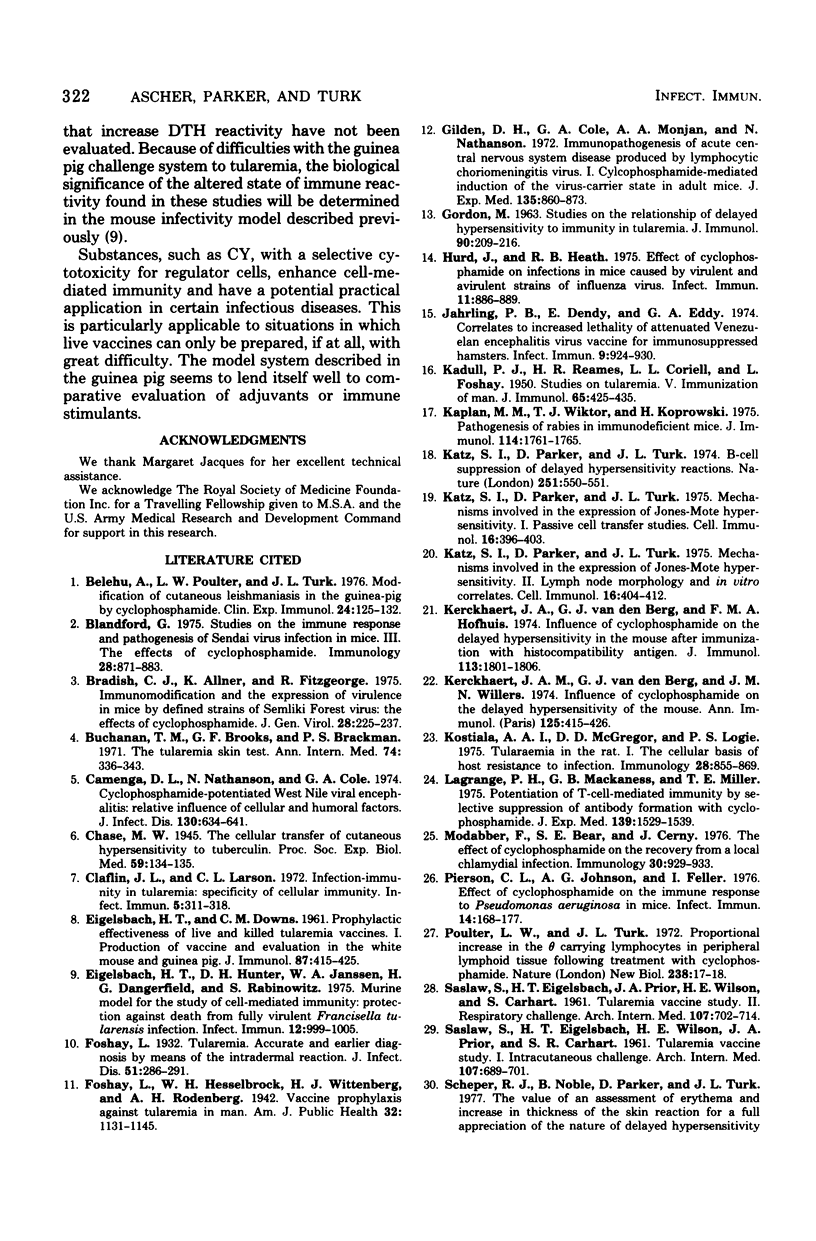
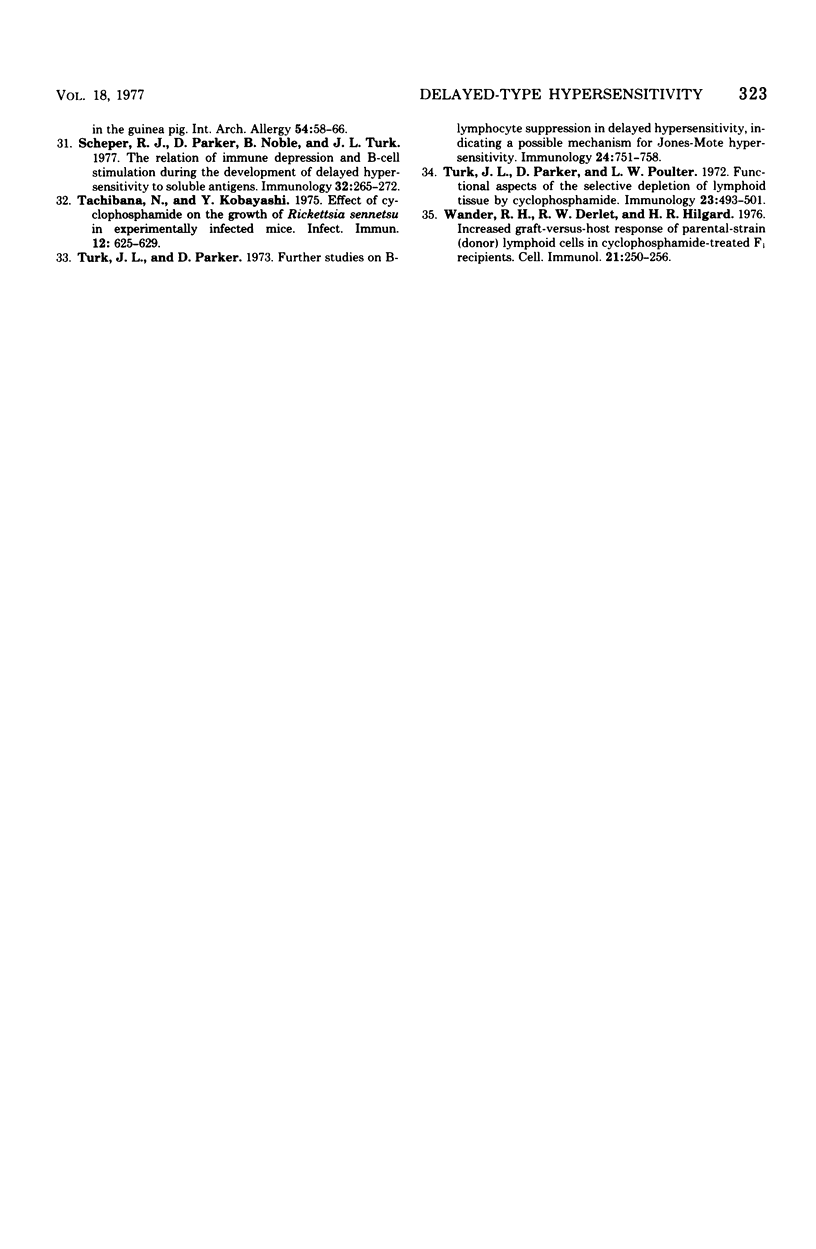
Selected References
These references are in PubMed. This may not be the complete list of references from this article.
- Barron L. D. Parity and optical activity. Nature. 1972 Jul 7;238(5358):17–19. doi: 10.1038/238017a0. [DOI] [PubMed] [Google Scholar]
- Belehu A., Poulter L. W., Turk J. L. Modification of cutaneous leishmaniasis in the guinea-pig by cyclophosphamide. Clin Exp Immunol. 1976 Apr;24(1):125–132. [PMC free article] [PubMed] [Google Scholar]
- Blandford G. Studies on the immune response and pathogenesis of Sendai virus infection of mice. III. The effects of cyclophosphamide. Immunology. 1975 May;28(5):871–883. [PMC free article] [PubMed] [Google Scholar]
- Bradish C. J., Allner K., Fitzgeorge R. Immunomodification and the expression of virulence in mice by defined strains of Semliki Forest virus: the effects of cyclophosphamide. J Gen Virol. 1975 Aug;28(2):225–237. doi: 10.1099/0022-1317-28-2-225. [DOI] [PubMed] [Google Scholar]
- Buchanan T. M., Brooks G. F., Brachman P. S. The tularemia skin test. 325 skin tests in 210 persons: serologic correlation and review of the literature. Ann Intern Med. 1971 Mar;74(3):336–343. doi: 10.7326/0003-4819-74-3-336. [DOI] [PubMed] [Google Scholar]
- Camenga D. L., Nathanson N., Cole G. A. Cyclophosphamide-potentiated West Nile viral encephalitis: relative influence of cellular and humoral factors. J Infect Dis. 1974 Dec;130(6):634–641. doi: 10.1093/infdis/130.6.634. [DOI] [PubMed] [Google Scholar]
- Claflin J. L., Larson C. L. Infection-immunity in tularemia: specificity of cellular immunity. Infect Immun. 1972 Mar;5(3):311–318. doi: 10.1128/iai.5.3.311-318.1972. [DOI] [PMC free article] [PubMed] [Google Scholar]
- EIGELSBACH H. T., DOWNS C. M. Prophylactic effectiveness of live and killed tularemia vaccines. I. Production of vaccine and evaluation in the white mouse and guinea pig. J Immunol. 1961 Oct;87:415–425. [PubMed] [Google Scholar]
- Eigelsbach H. T., Hunter D. H., Janssen W. A., Dangerfield H. G., Rabinowitz S. G. Murine model for study of cell-mediated immunity: protection against death from fully virulent Francisella tularensis infection. Infect Immun. 1975 Nov;12(5):999–1005. doi: 10.1128/iai.12.5.999-1005.1975. [DOI] [PMC free article] [PubMed] [Google Scholar]
- Foshay L., Hesselbrock W. H., Wittenberg H. J., Rodenberg A. H. Vaccine Prophylaxis against Tularemia in Man. Am J Public Health Nations Health. 1942 Oct;32(10):1131–1145. doi: 10.2105/ajph.32.10.1131. [DOI] [PMC free article] [PubMed] [Google Scholar]
- GORDON M. Studies on the relationship of delayed hypersensitivity to immunity in tularemia. J Immunol. 1963 Feb;90:209–216. [PubMed] [Google Scholar]
- Gilden D. H., Cole G. A., Monjan A. A., Nathanson N. Immunopathogenesis of acute central nervous system disease produced by lymphocytic choriomeningitis virus. I. Cyclophosphamide-mediated induction by the virus-carrier state in adult mice. J Exp Med. 1972 Apr 1;135(4):860–873. doi: 10.1084/jem.135.4.860. [DOI] [PMC free article] [PubMed] [Google Scholar]
- Hurd J., Heath R. B. Effect of cyclophosphamide on infections in mice caused by virulent and avirulent strains of influenza virus. Infect Immun. 1975 May;11(5):886–889. doi: 10.1128/iai.11.5.886-889.1975. [DOI] [PMC free article] [PubMed] [Google Scholar]
- Jahrling P. B., Dendy E., Eddy G. A. Correlates to increased lethality of attenuated Venezuelan encephalitis virus vaccine for immunosuppressed hamsters. Infect Immun. 1974 May;9(5):924–930. doi: 10.1128/iai.9.5.924-930.1974. [DOI] [PMC free article] [PubMed] [Google Scholar]
- KADULL P. J., REAMES H. R., CORIELL L. L., FOSHAY L. Studies on tularemia. V. Immunization of man. J Immunol. 1950 Oct;65(4):425–435. [PubMed] [Google Scholar]
- Kaplan M. M., Wiktor T. J., Koprowski H. Pathogenesis of rabies in immunodeficient mice. J Immunol. 1975 Jun;114(6):1761–1765. [PubMed] [Google Scholar]
- Katz S. I., Parker D., Turk J. L. B-cell suppression of delayed hypersensitivity reactions. Nature. 1974 Oct 11;251(5475):550–551. doi: 10.1038/251550a0. [DOI] [PubMed] [Google Scholar]
- Katz S. I., Parker D., Turk J. L. Mechanisms involved in the expression of Jones-Mote hypersensitivity. I. Passive cell transfer studies. Cell Immunol. 1975 Apr;16(2):396–403. doi: 10.1016/0008-8749(75)90128-8. [DOI] [PubMed] [Google Scholar]
- Katz S. I., Parker D., Turk J. L. Mechanisms involved in the expression of Jones-Mote hypersensitivity. II. Lymph node morphology and in vitro correlates. Cell Immunol. 1975 Apr;16(2):404–412. doi: 10.1016/0008-8749(75)90129-x. [DOI] [PubMed] [Google Scholar]
- Kerckhaert J. A., Van den Berg G. J., Willers J. M. Influence of cyclophosphamide on the delayed hypersensitivity of the mouse. Ann Immunol (Paris) 1974 Mar-Apr;125(3):415–426. [PubMed] [Google Scholar]
- Kerckhaert J. A., van den Berg G. J., Hofhuis F. M. Influence of cyclophosphamide on the delayed hypersensitivity in the mouse after immunization with histocompatibility antigen. J Immunol. 1974 Dec;113(6):1801–1806. [PubMed] [Google Scholar]
- Kostiala A. A., McGregor D. D., Logie P. S. Tularaemia in the rat. I. The cellular basis on host resistance to infection. Immunology. 1975 May;28(5):855–869. [PMC free article] [PubMed] [Google Scholar]
- Lagrange P. H., Mackaness G. B., Miller T. E. Potentiation of T-cell-mediated immunity by selective suppression of antibody formation with cyclophosphamide. J Exp Med. 1974 Jun 1;139(6):1529–1539. doi: 10.1084/jem.139.6.1529. [DOI] [PMC free article] [PubMed] [Google Scholar]
- Modabber F., Bear S. E., Cerny J. The effect of cyclophosphamide on the recovery from a local chlamydial infection. Guinea-pig inclusion conjunctivitis (GPIC). Immunology. 1976 Jun;30(6):929–933. [PMC free article] [PubMed] [Google Scholar]
- Pierson C. L., Johnson A. G., Feller I. Effect of cyclophosphamide on the immune response to Pseudomonas aeruginosa in mice. Infect Immun. 1976 Jul;14(1):168–177. doi: 10.1128/iai.14.1.168-177.1976. [DOI] [PMC free article] [PubMed] [Google Scholar]
- SASLAW S., EIGELSBACH H. T., PRIOR J. A., WILSON H. E., CARHART S. Tularemia vaccine study. II. Respiratory challenge. Arch Intern Med. 1961 May;107:702–714. doi: 10.1001/archinte.1961.03620050068007. [DOI] [PubMed] [Google Scholar]
- SASLAW S., EIGELSBACH H. T., WILSON H. E., PRIOR J. A., CARHART S. Tularemia vaccine study. I. Intracutaneous challenge. Arch Intern Med. 1961 May;107:689–701. doi: 10.1001/archinte.1961.03620050055006. [DOI] [PubMed] [Google Scholar]
- Scheper R. J., Noble B., Parker D., Turk J. L. The value of an assessment of erythema and increase in thickness of the skin reaction for a full appreciation of the nature of delayed hypersensitivity in the guinea pig. Int Arch Allergy Appl Immunol. 1977;54(1):58–66. doi: 10.1159/000231808. [DOI] [PubMed] [Google Scholar]
- Scheper R. J., Parker D., Noble B., Turk J. L. The relation of immune depression and B-cell stimulation during the development of delayed hypersensitivity to soluble antigens. Immunology. 1977 Feb;32(2):265–272. [PMC free article] [PubMed] [Google Scholar]
- Tachibana N., Kobayashi V. Effect of cyclophosphamide on the growth of Rickettsia sennetsu in experimentally infected mice. Infect Immun. 1975 Sep;12(3):625–629. doi: 10.1128/iai.12.3.625-629.1975. [DOI] [PMC free article] [PubMed] [Google Scholar]
- Turk J. L., Parker D. Further studies on B-lymphocyte suppression in delayed hypersensitivity, indicating a possible mechanism for Jones-Mote hypersensitivity. Immunology. 1973 Apr;24(4):751–758. [PMC free article] [PubMed] [Google Scholar]
- Turk J. L., Parker D., Poulter L. W. Functional aspects of the selective depletion of lymphoid tissue by cyclophosphamide. Immunology. 1972 Oct;23(4):493–501. [PMC free article] [PubMed] [Google Scholar]
- Wander R. H., Derlet R. W., Hilgard H. R. Increased graft-versus-host response of parental-strain (donor) lymphoid cells in cyclophosphamide-treated F1 recipients. Cell Immunol. 1976 Feb;21(2):250–256. doi: 10.1016/0008-8749(76)90054-x. [DOI] [PubMed] [Google Scholar]


